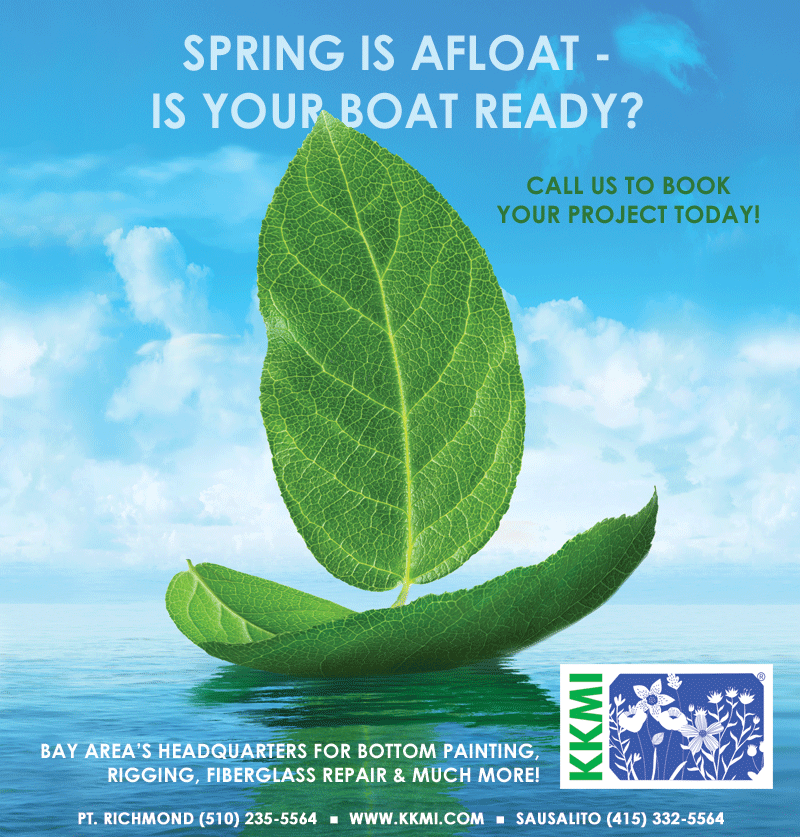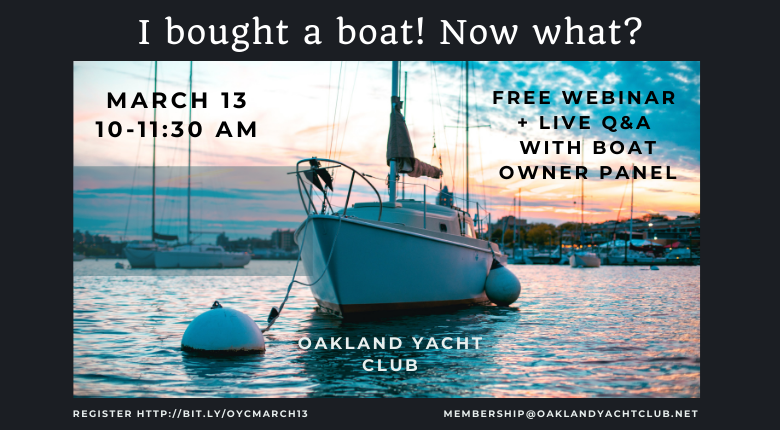
Bay Area Gearing Up for Summer Youth Sailing
In this month’s Latitude 38 Heather Breaux explores summer youth sailing opportunities throughout the Bay Area.
Summer is coming — and the Bay is waiting for your kids! Whether you live in the North Bay, or right on the water in Alameda County, summer youth sailing is at the heart of Bay Area sailing.
The island community in Alameda is home to many water people: stand-up paddlers, swimmers and kayakers. But connecting the community to sailing has proven to be the main challenge in building the youth program at Alameda Community Sailing Center. “It’s very important to get more people into sailing,” says program director Emily Zugnoni, “especially people who don’t come from sailing families, and those who don’t even know what a yacht club is.”
Of course, the dream is that kids will fall in love with the sport, the water, and the community, and eventually bring their own children and grandchildren to sail. All it takes is the curiosity of one kid looking for fun to introduce a new generation of sailors to the community.
Last year saw the launch of a new US Sailing Initiative to get youth into sailing who are traditionally underrepresented in sailing clubs. San Francisco Bay is one of the regions designated for three Siebel Sailor Programs, including ACSC. “We are trying to build people who love sailing, and care about the water,” says Zugnoni. “People who want to try new things, and get outside their comfort zones.” Sailing campers play games, do drills, have adventures, and grow into responsible, brave young adults.
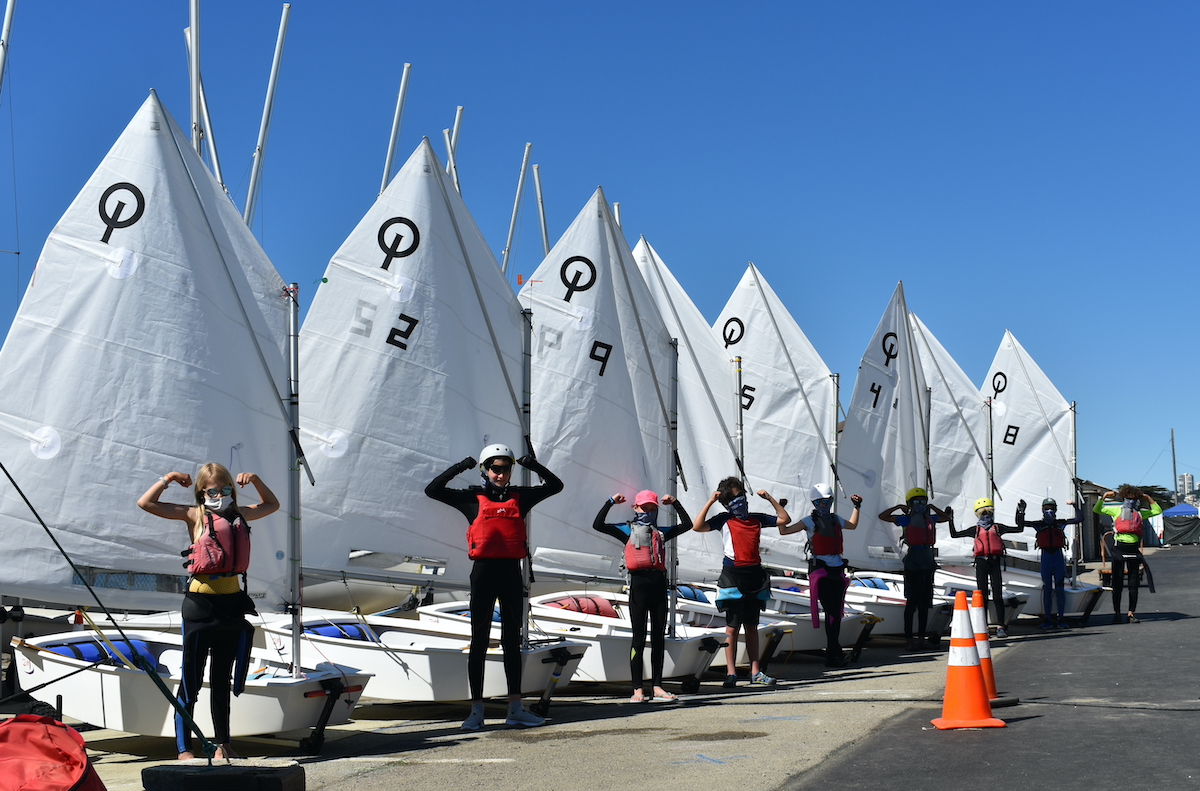
. . . . . . . .
Sailing is an adventure. It is fun and games, but the personal growth achieved on a boat lasts a lifetime: teamwork, courage, and overcoming fears.
Whether you’re looking for racing, community sailing, or more educational sailing, the Bay Area has extensive resources. Latitude 38 has created a one-stop resource to discover the right club for you this spring and summer. Check out a complete list of Bay Area youth sailing opportunities here.
And, you can read Heather’s complete story about summer youth sailing on the Bay at Latitude38.com.
The Navigating Mastery of ‘Flying Cloud’s Eleanor Creesy
One of the greatest records in all of sailing was claimed by the famed clipper ship Flying Cloud, which sailed from New York to San Francisco in 1851 in just under 90 days, then bested that mark three years later. Lost in the lore of Flying Cloud is the story of the ship’s navigator, Eleanor Creesy. To our knowledge, there is no “complete” narrative of Creesy, but rather, a series of anecdotes.* There are no photographs of the iconic navigator, either, even though she lived through the birth and proliferation of photography. (*Thank you to the readers who mentioned David W. Shaw’s book, Flying Cloud: The True Story of America’s Most Famous Clipper Ship and the Woman Who Guided Her, in the comments to this story.)
Born in Marblehead, Massachusetts, in 1814, Creesy learned how to navigate from her father, John Prentiss, captain of the schooner Californian, according to the book A World of Her Own: 24 Amazing Women Explorers and Adventurers. “The townsfolk gossiped when Captain Prentiss instructed his daughter in the basics of navigation,” reads A World of Her Own. “They couldn’t understand why he was teaching Eleanor a skill that was practiced solely by men. In the 1820s, very few girls attended school. But Captain Prentiss loved navigation, and since he didn’t have a son as an apprentice, he saw no reason not to pass his knowledge on to his clever and interested daughter.”
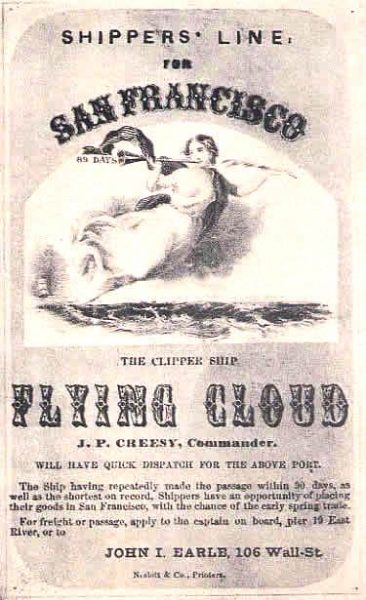
“For Eleanor, navigation was not only a joy, but a path to a bigger life than that available to a Marblehead wife,” A World of Her Own continues. “She wished for a life at sea, and hoped her training in navigation would earn her a place aboard a ship.” At age 26, Eleanor met Captain Josiah Perkins Creesy, who was only six months her senior, but had been in command of a ship for three years. “Eleanor and Perkins’ marriage was a partnership both in love and occupation.”
The Creesys sailed some 10 years aboard Oneida, including several trips to China. But the couple had never been around Cape Horn. In 1851, the captain/navigator duo took command of the Boston-built Flying Cloud, the most famous of the clipper ships built by master designer Donald McKay. In April 1851, a reporter for the Boston Daily Atlas wrote of the new vessel: “If great length [235 ft], sharpness of ends, with proportionate breadth [41 ft] and depth, conduce to speed, the Flying Cloud must be uncommonly swift, for in all these she is great.”
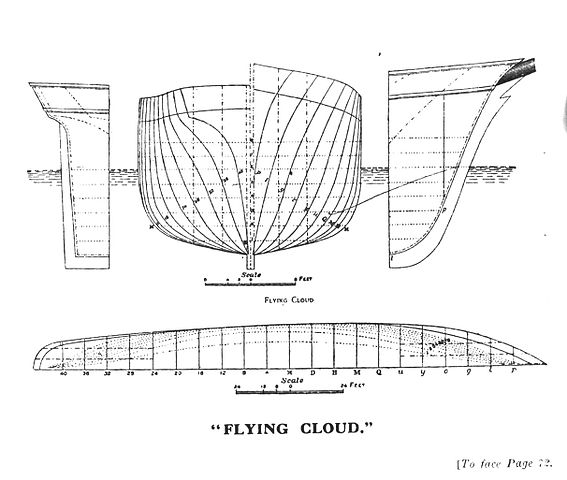
Before Flying Cloud made its historic voyage, Creesy read Explanations and Sailing Directions to Accompany the Wind and Current Charts by Matthew Fontaine Maury, who was considered the father of oceanography. The book “was viewed with some skepticism by old ship captains,” according to the New England Historical Society (NEHS). “It was based on exhaustive studies of the logs kept by naval and merchant ships. Maury recommended a new route around Patagonia that Creesy decided to follow.”
Within six weeks after her 1851 launch, Flying Cloud sailed out of New York Harbor, bound for Cape Horn and then San Francisco. “The first time Eleanor Creesy calculated how far Flying Cloud had traveled in a day, she thought she’d made a mistake,” NEHS wrote. She couldn’t believe the ship was that fast. She checked for mistakes. In one day, Flying Cloud covered 389 miles, a greater distance than had ever been covered in a day, even by steamships.”
Flying Cloud arrived in San Francisco 89 days and 21 hours after departing New York. Typically, the New York-to-San Francisco voyage — which is colloquially known as the “Gold Rush Route” — took some 200 days. “In the wake of their record-setting transit from New York to California, Eleanor and Josiah became instant celebrities,” said Wikipedia. “But their fame was short-lived and their story was quickly forgotten.”
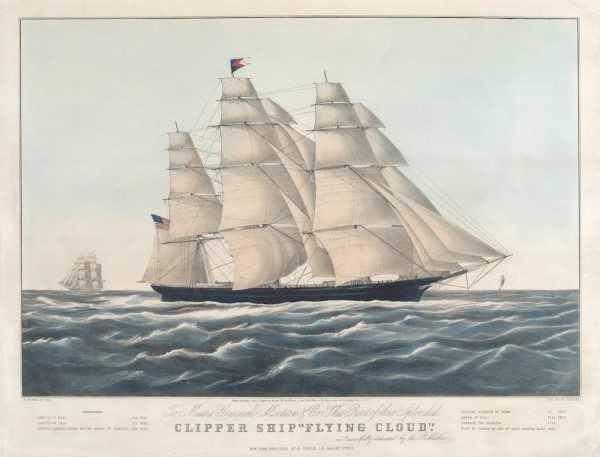
Two years after their historic voyage, Josiah and Eleanor Creesy broke their record by 13 hours, according to NEHS. “They continued to sail together until the Civil War, when Josiah volunteered as a lieutenant, commanding a small clipper ship. After the war, the Creesys retired from the sea and lived on a farm in Salem, Massachusetts. John died in 1871; Eleanor lived to be 85, passing away in August 1900.”
In 1989, Warren Luhrs, aboard the 60-ftThursday’s Child, finally broke Eleanor Creesy’s record, sailing the Gold Rush Route in 80 days and 20 hours. In 1998, skipper Yves Parlier and crew made the passage in the 60-ft Aquitaine Innovations in 57 days and three hours. (In 2008, the 109-ft catamaran Gitana 13 sailed the route in 43 days and 38 minutes.) Finally, in 2013, Giovanni Soldini led an international crew aboard a Volvo 70, sailing the Gold Rush Route in 47 days.
At the awards ceremony in San Francisco, Soldini paid homage to Eleanor Creesy. “She chose a nearly perfect route, with no information, no satellites, no anything. She really was a fantastic navigator. Much better than I.”
Sail into Spring with KKMI
San Francisco South Bay Shipping News
We were talking with Drew Harper of Spinnaker Sailing San Francisco the other day, when he mentioned the 23 ships he saw anchored in the South Bay. “What’s the South Bay shipping news?” he asked. It turns out all those pandemic Peloton rides to nowhere have to come from somewhere. Surprise, they all come from China. The New York Times says we are seeing excess ships in harbors waiting to be unloaded because of pandemic changes in shopping habits and logistical logjams created by worker challenges, caused by COVID.
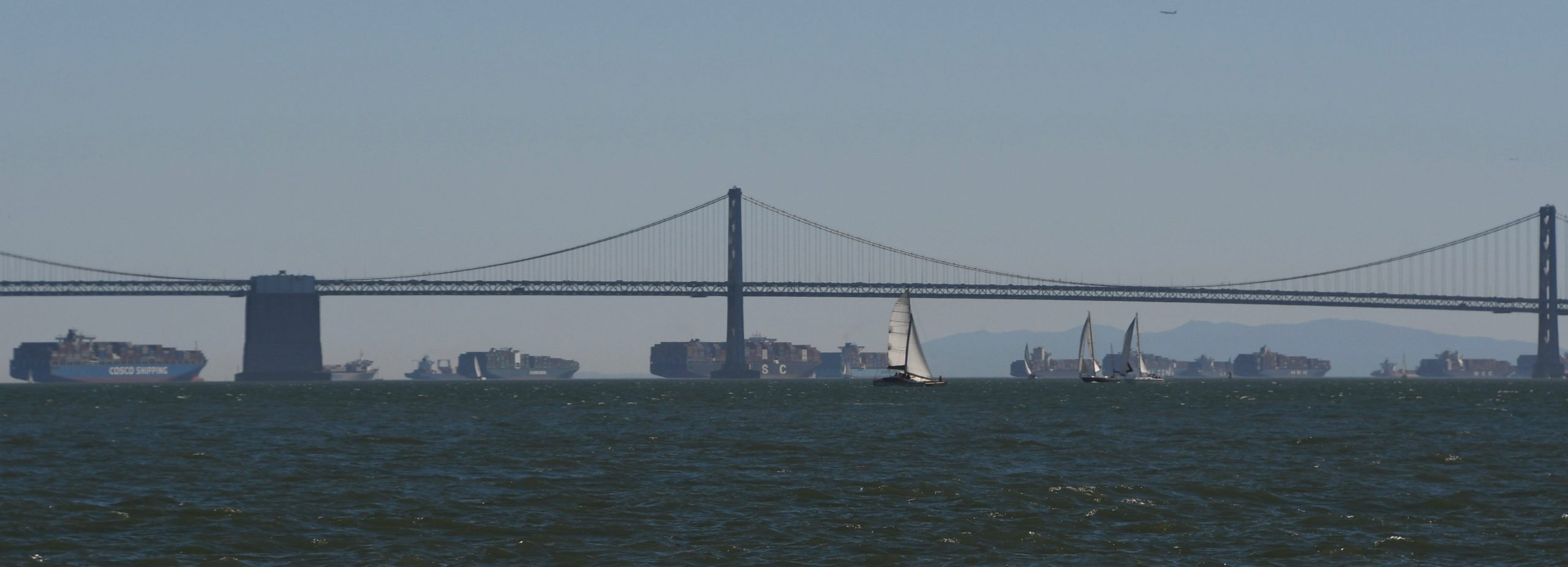
The New York Times reported, “Pressure built as Americans refashioned their spending. Deprived of vacations and restaurant meals, they bought video game consoles and pastry mixers. They outfitted their homes for remote work and distance learning.
“At the twin ports of Los Angeles and nearby Long Beach, unloading has been slowed by a dearth of dockworkers and truck drivers as the virus has sickened some while forcing others to quarantine.”
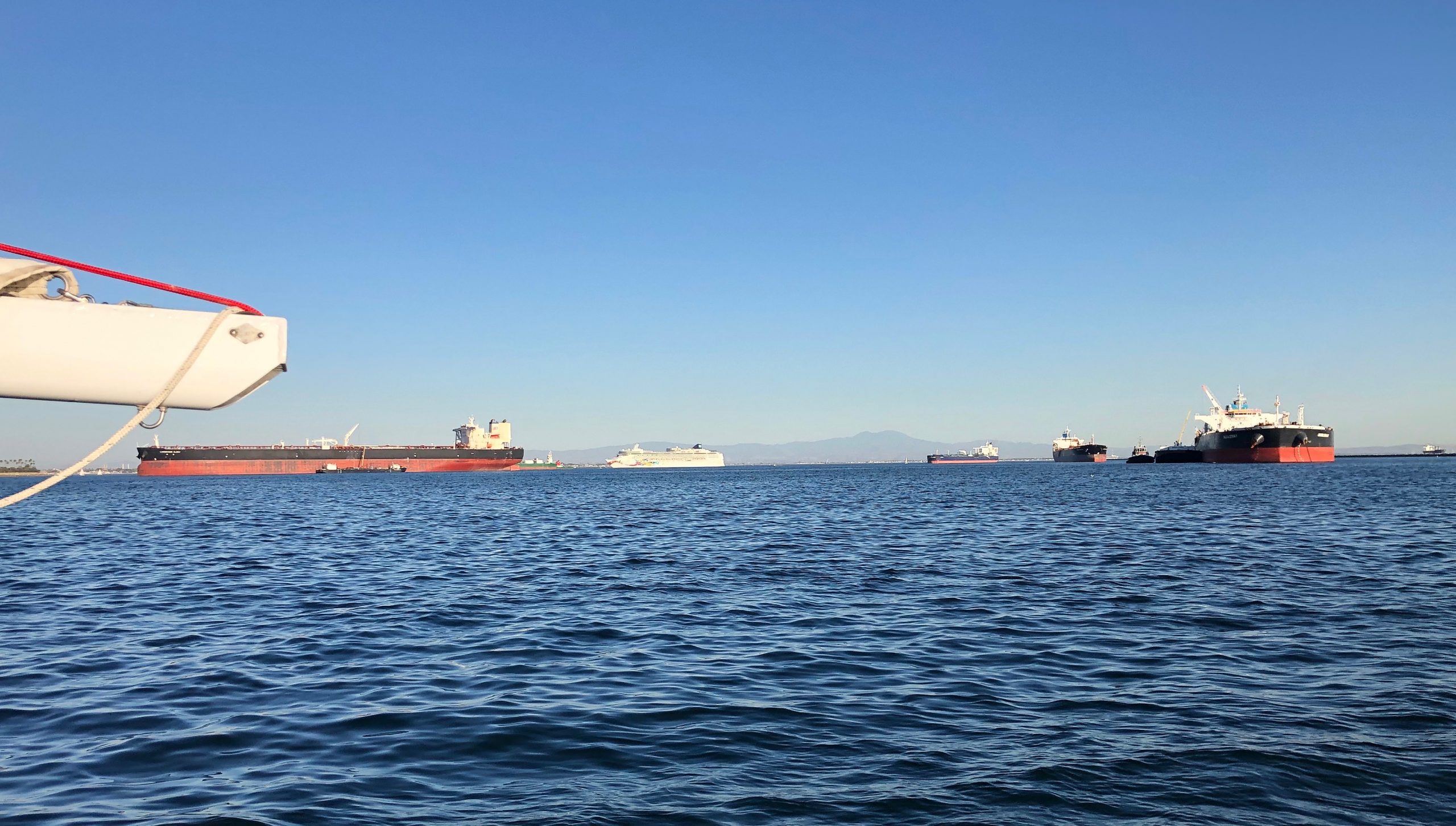
The Times quoted the Port of Oakland’s maritime director, Bryan Brandes. “‘In normal times, vessels come directly into Oakland,'” Mr. Brandes said. “’Right now, we’re ranging anywhere from seven to 11 vessels at anchorage.'” That number can certainly change as the management of the shoreside workforce fluctuates due to the pandemic.
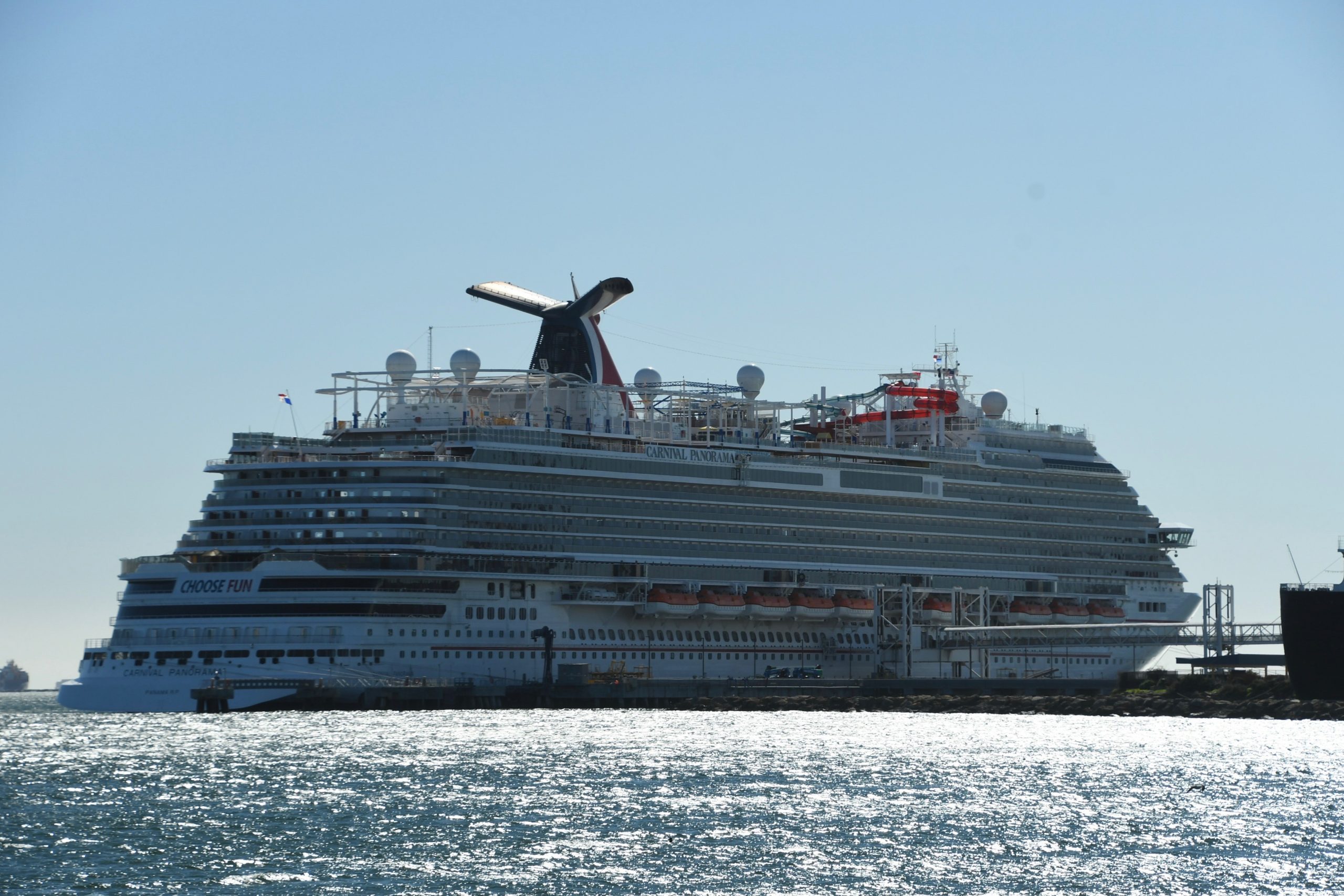
If you’re headed out for a sail with the kids over the weekend, the large number of ships could provide a great experiential opportunity for a geography and flag lesson. You could sail between ships that are almost as big as the islands they call home — so the kids could sail to Panama, St. Vincent, the Bahamas, Malta, Cyprus or whatever else is in the mix. You could also teach them about flags of convenience, offshore banking, international liability laws, tax havens, how bananas get here, the source of all their game consoles, and other interesting lessons from the shipping industry.
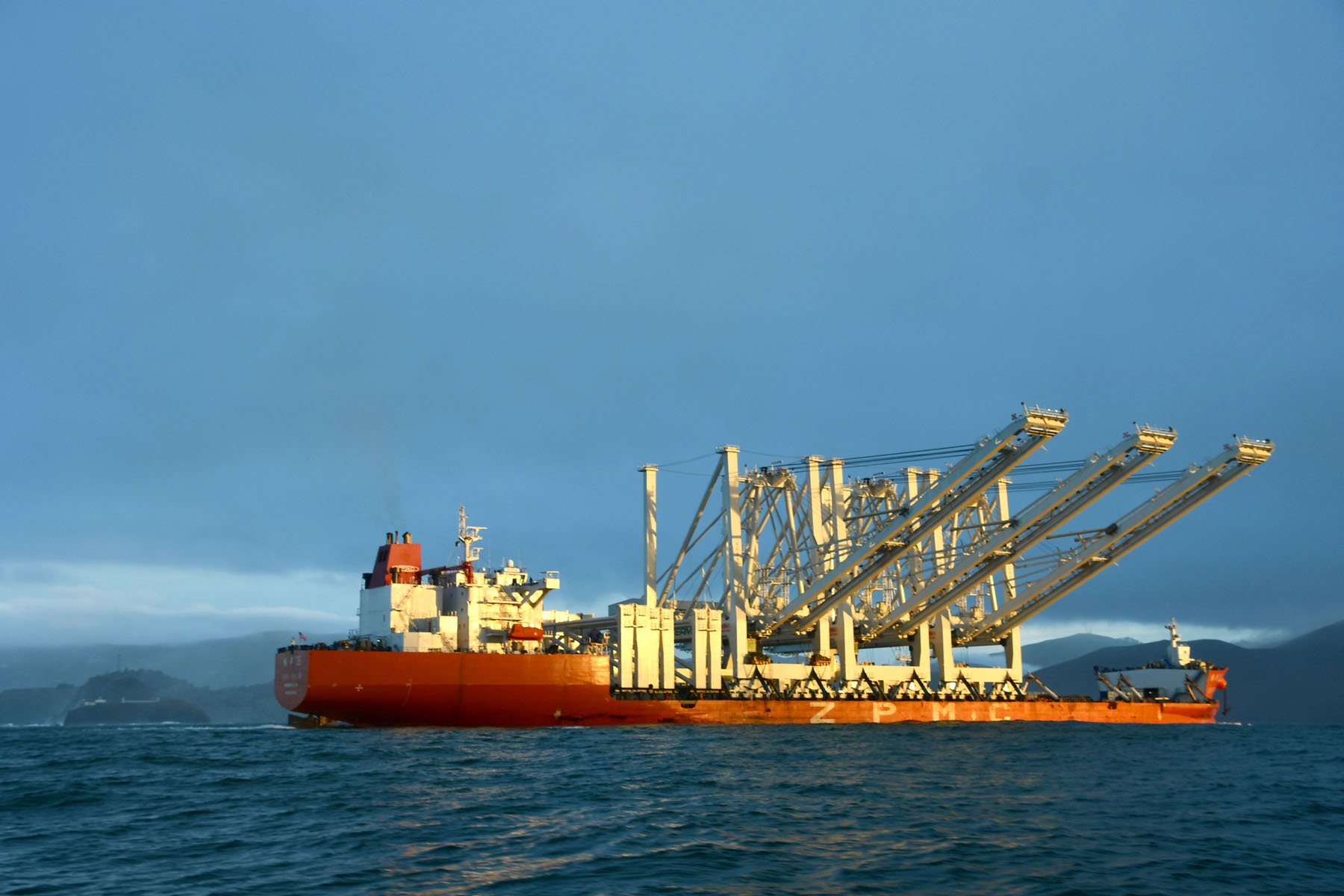
The Times story projected that the logjam might ease up by the end of summer, though by then we’ll be heading toward the Christmas rush. In the meantime, you can expect to see an extra-large fleet of ships anchored off California shipping terminals.
Californian Melanie Roberts: Globetrotting Race Committee Official
When the boats cross the starting line at the 36th America’s Cup Final on March 10, San Diego sailor and race official Melanie Roberts will be one of the very few Americans on the course as Emirates Team New Zealand prepares to defend the Auld Mug from its hard-charging challengers. Melanie is proud testimony to the tenacity of a young girl’s dream to be a part of the international racing circuit, albeit from the deck of a race committee boat rather than the cockpit of a racing craft.
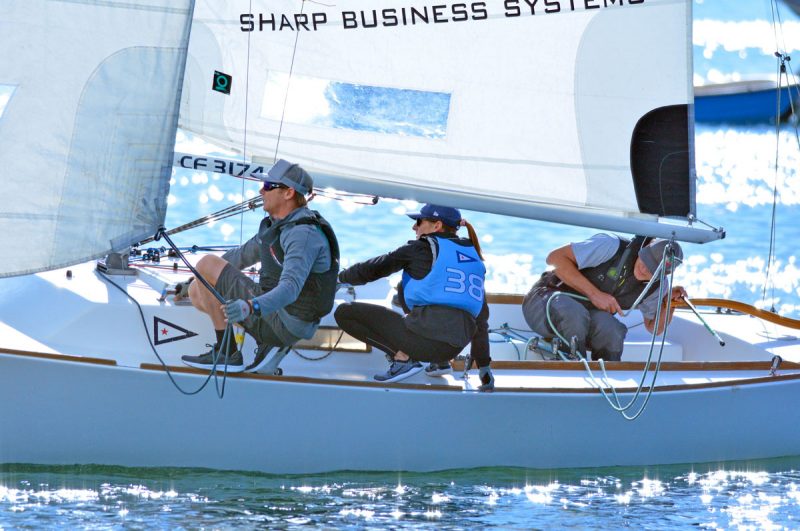
Melanie’s journey to the pinnacle of her sport started when she was a junior sailor, barely old enough to see over the transom of her Sabot dinghy, at San Diego Yacht Club. The budding 9-year-old sailor was heartbroken when she witnessed the Australian entry, oneAustralia, break in half and sink off the coast of San Diego. She was so distressed that she sent a letter, along with $5, to the Australian team to help with the rebuild.
Team oneAustralia skipper John Bertrand returned her money with a note of encouragement that read in part, “It was very kind of you to send us $5, but I am pleased to say that we have not had to use your money and I am returning it to you.”
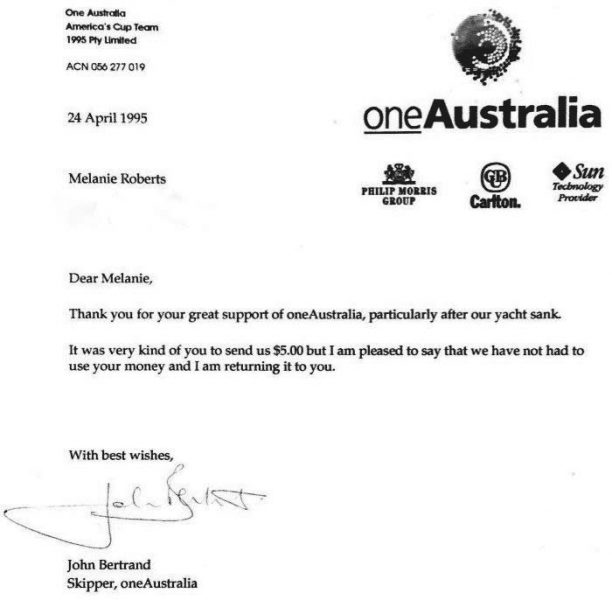
It seems the young sailor was a voracious letter writer. She also penned a note of congratulations to New Zealand’s winning team. The Kiwi team tacked the missive to the wall of their Shelter Island compound and replied with their own note of thanks to the young sailor.
Roberts has brought both of these notes to Auckland as she begins her third stint as an America’s Cup race official. It is no small coincidence that her boss, America’s Cup race director Iain Murray, was on board oneAustralia when it sank in 1995.
“He’s the best boss to work for,” Roberts says. “He was one of my early sailing heroes. Now to be working side by side with him is an honor and a privilege.”
Murray is eager to return the compliment. “Having someone like Melanie on the committee boat makes my job that much easier. I depend on her for calm communications with the boats. The fact that we have worked together before makes it all the better.”
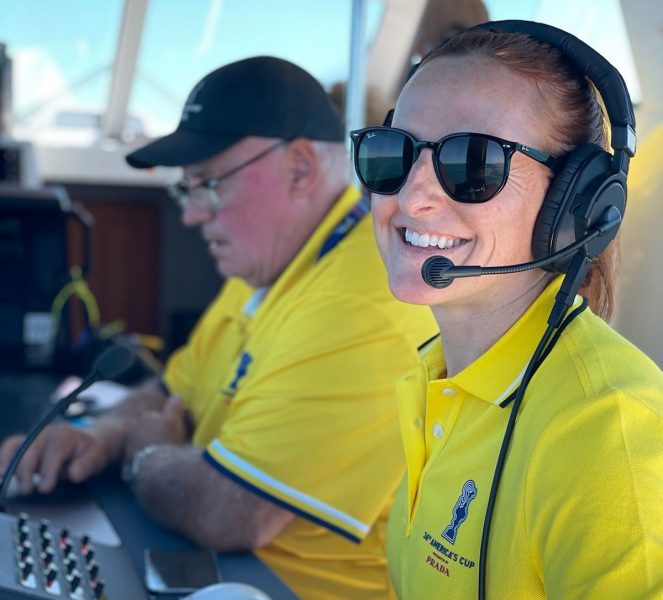
The 35-year-old Roberts has sailed competitively all her life. She got into race committee work when she took a job as race coordinator at St. Francis YC in San Francisco after she finished college at USC.
When the Cup came to San Francisco in 2013, she “was in the right place at the right time” to sign up for the race committee. “I never gave up communicating with race officials,” she said. “I just kept at it until someone noticed my interest and gave me a chance.”
Roberts signed on to work with Murray as a software operations liaison in the 2017 America’s Cup in Bermuda.
In Auckland, she functions as de facto assistant race director. Her job aboard the signals boat is to communicate with the teams and keep track of mark roundings and course corrections. It is her calm and collected voice that can be heard in on-site broadcasts as she relays key information to the boats on the course. “Most times,” she says, “I text the coaches rather than interrupting the team’s onboard coms. You would think this would be a very stressful job, but I am so busy with my communications that the only time I get to watch the races is after the fact on the video replays.”
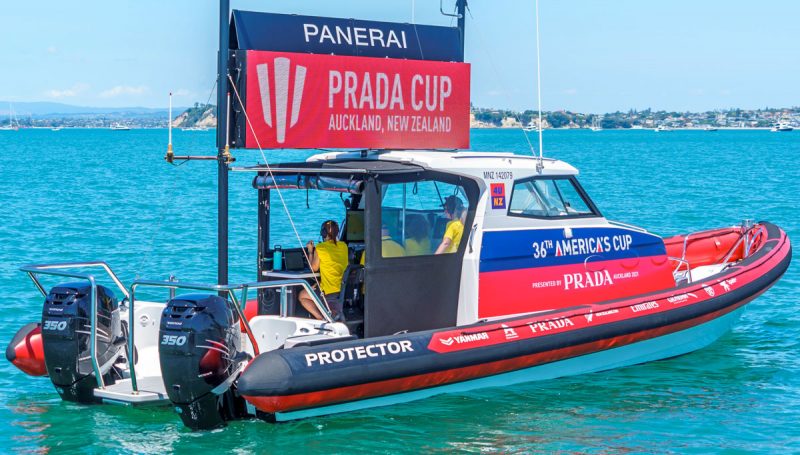
Race day for Roberts starts the night before, when she and Murray set the course for the next day’s races. In Auckland, there are five possible race venues. Which one is selected is determined by wind, waves and on-site conditions. “We tell the teams what we are thinking by 8 p.m. the night before. Then, we firm it all up the next day at the 10:30 briefing.”
The five-person crew of the signals boat “gets out on the water about two hours prior to race time. We make any last-minute course adjustments at that time and communicate it all to the teams.”
Thus far into the 36th edition of the America’s Cup, the race committee has not had to deal with major rules infractions. “The computer calls the fouls and boundary incursions. We just have to communicate in a clear and concise manner to the teams when necessary.”
The RC did make a somewhat controversial call regarding which course to race during the last day of the Prada Cup Finals. The ultimate decision which course to race was dictated as much by COVID restrictions as by race conditions. Some INEOS Team UK backers say the course chosen favored the “faster boat,” while the course the teams utilized the day before favored “the better sailors.” In the end, it didn’t matter. Italy’s Luna Rossa soundly defeated the Brits 7-1 in the best-of-13 matches.
Roberts says her job isn’t much different in this Cup versus her role in Bermuda. “But the fact that these AC75s are so fast makes everything we do more time-sensitive.”
“Being a race official is like being chess master. You always have to be thinking a few moves ahead to get ready to complete one race and get ready for the next.”
She also says that the necessity of running a race “on time to coordinate with broadcasting schedules” sometimes creates a conflict between running a quality race and sticking to a schedule.
Roberts has been in New Zealand since early December. She will stay until the America’s Cup concludes in mid- to late March.
She was on the water when New York YC’s American Magic Patriot almost sank after capsizing during the round robins of the Prada Cup. “We got up there after we finished the race with Luna Rossa. We stood by to assist in any way we could. It was a real bummer to see that boat almost go under.”
Interestingly, Roberts says that she and American Magic skipper Terry Hutchinson have continued to keep in touch during subsequent races. “Terry texted me the other day from the Village about a change he was seeing in the race conditions. I was glad to get that update, as we didn’t have a good idea of what to expect at that particular time.”
“After the Cup concludes,” she says, “it’s off to Bermuda, where I will be working the race committee boat for the SailGP Series.” Roberts has been involved with this high-octane racing circuit since its debut two years ago. She’s excited to see what this year’s expanded schedule and increased number of teams will bring.
This year, eight ‘national’ teams of sailors will compete in a winner-take-all series of races with a $1,000,000 prize. Venues for this year’s events will be in Bermuda, Australia, Denmark, France, Great Britain, Japan, New Zealand, Spain and the US. The Australian team, captained by Tom Slingsby, won the inaugural edition of the series.
“I’ve got my bags packed and my passport ready,” says the globetrotting Roberts. “The racing will be close and competitive.” She says it’s a who’s who of racing’s elite with Jimmy Spithill, Nathan Outterridge, Tom Slingsby, Ben Ainslie and Peter Burling squaring off. “It’s anybody’s guess who will come out on top.”
Roberts is optimistic about more women obtaining roles in race management and/or participating in performance sailing at the international level. “While there aren’t any women on the crews of the America’s Cup teams, there are lots of women in leadership roles within the teams themselves — in design, communications, events, logistics. That all helps and creates a pathway for future gender equality.”
Roberts notes that several women are signed on as sailing crew members with the new edition of the SailGP series. “The Magenta Project will go a long way toward creating more opportunities for women in all aspects of the sport. I hope that in the years to come we’ll see an all-female boat competing for the Cup — with a full complement of female race committee members as well.”
For the time being, Roberts is proud to hold one of the most prestigious spots in international race management. “At the end of the day, I’m just a race official doing my job to the best of my ability. It doesn’t matter if I’m a man or a woman. The rules rule in America’s Cup racing. I’m just happy to do my part to put on a great race for the participants and the fans all across the world.”
I Bought A Boat! Now What?
Free Webinar
A new boat means exciting new opportunities and new responsibilities. Learn about boat ownership from our experienced panel of boat owners. We will focus on getting to know your boat, maintenance, and finding your tribe to help you enjoy all the Bay has to offer. This is an interactive session so bring all your questions! Power boaters and sailors welcome.
Saturday March 13, 2021 10-11:30 a.m.
For registration information, go to www.oaklandyachtclub.net or call 510.522-6868.
Do You Tie a Knot or Tie a Lot?
Have you ever heard the expression “If you can’t tie a knot, tie a lot?” Surely every sailor has either said it or had it said to them (though hopefully only at the very beginning of their sailing careers). Recently we’ve seen a few social media posts about knot tying, and it reminded this writer of her own early knot-tying attempts. Yes, she sometimes did tie a lot instead of a knot. Though she defends her actions with claims that when faced with the option of tying a ‘proper’ knot or getting the job done, a strategic set of twists, turns, loops and follow-throughs seemed at times the best solution. However, eventually it became apparent that real knots have a purpose and ultimately a better result than an unruly tangle of line.
So how does an inexperienced sailor learn her knots without driving her captain and fellow crew crazy, or worse, getting herself tossed overboard? Well, fortunately the internet is a gold mine of information about a plethora of topics, including knot tying. And to make it even better, there are entire pages and videos devoted specifically to the best and most useful knots for sailors and boaters in general. How good is that?
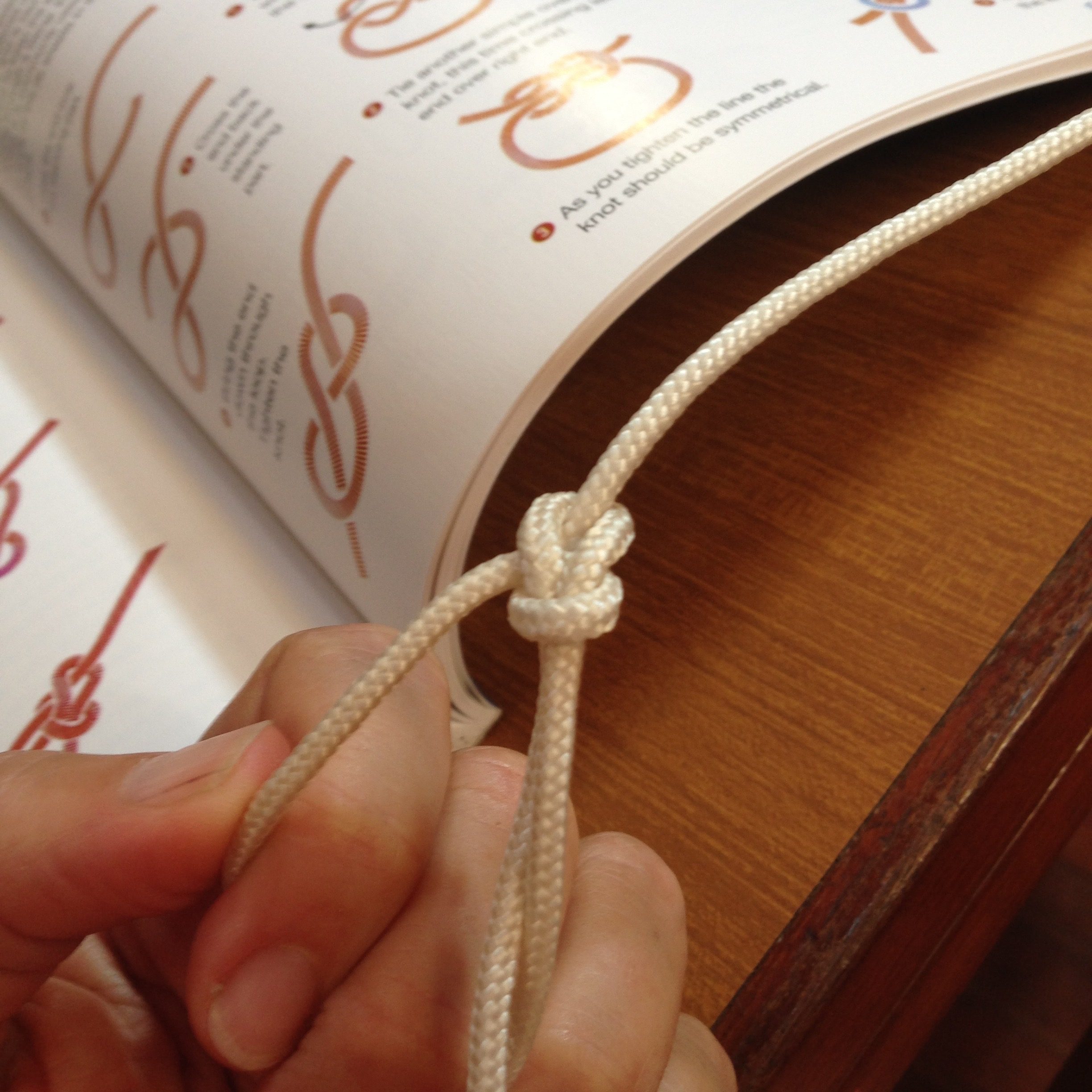
Though the number varies a little, consensus suggests there are a handful of knots that, when mastered, can be applied to almost every situation a sailor will encounter. For example, Discover Boating says there are five basic and commonly used boating knots: the bowline, cleat hitch, clove hitch, half hitch and figure eight. The site then gives you a step-by-step instructional video for each. SAIL magazine says there are seven essential knots for sailors, including the stopper knot, sheet bend, two half hitches and rolling hitch in their knot-tying tutorial. And in keeping things simple, ASA demonstrates the bowline, clove hitch and cleat hitch as their basic “three very important sailing knots.”
But what grabbed our attention was a video called “Learn 5 Knots for Sailing.” In this video, Emily (from Emily & Clark’s Adventure) says these five knots are “the only ones ya need” — stopper knot (figure 8), clove hitch, bowline, alpine butterfly, and zeppelin bend. Admittedly, and at the risk of sounding uneducated, this sailor wasn’t familiar with the last two names but did find Emily’s instructions quite easy to follow, and a good resource for someone who still struggles with her knots.
What are your ‘go-to’ sailing knots?

